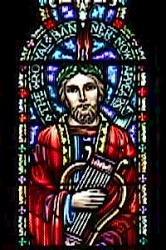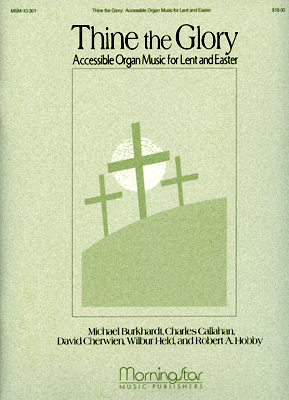- |
User Links
Hail Thee, Festival Day

Lo, the fair beauty of earth
Author: Venantius Honorius Clementianus FortunatusTune: SALVE FESTA DIES (Vaughan Williams)
Published in 19 hymnals
Printable scores: PDFAudio files: MIDI, Recording
Representative Text
[Refrain:]
Hail, glad festival day!
Blest day to be hallowed for ever,
day wherein Christ arose,
breaking the kingdom of death.
[Easter:]
1 Lo, the fair beauty of earth,
from the death of the winter arising,
every good gift of the year
now with its Saviour returns. [Refrain]
2 He who was nailed to the cross
is God and the ruler of all things;
all things created on earth
worship the maker of all. [Refrain]
3 Mourning they laid you to rest,
the author of life and creation;
treading the pathway of death,
life now bestowing on all. [Refrain]
4 God of all pity and power,
let your word be assured to the doubting:
light on the third day returns;
rise, Son of God, from the tomb! [Refrain]
[Ascension:]
1 Christ in his triumph ascends,
who had vanquished the devil's dominion;
bright is the woodland with leaves,
brilliant the meadows with flowers. [Refrain]
2 Daily the loveliness grows,
adorned with glory of blossom;
heaven its gates now unbars,
flinging its increase of light. [Refrain]
3 Jesus, the health of the word,
enlighten our minds, great Redeemer,
Son of the Father supreme,
only-begotten of God! [Refrain]
4 Praise to the giver of good!
O Lover and Author of concord,
pour out your balm on our days;
order our days in your peace. [Refrain]
[Pentecost:]
1 Lo, in the likeness of fire,
on those who await his appearing,
he whom the Lord foretold
suddenly, swiftly descends: [Refrain]
2 Forth to the faithful he comes
with sevenfold mystical offering,
pouring on all human souls
infinite riches of God. [Refrain]
3 Hark! for in myriad tongues
Christ's own, his chosen apostles,
preach to the ends of the earth
Christ and his wonderful works. [Refrain]
4 Praise to the Spirit of life,
all praise to the fount of our being,
light that now lightens all,
life that in all now abides. [Refrain]
Source: Voices United: The Hymn and Worship Book of The United Church of Canada #163
Author: Venantius Honorius Clementianus Fortunatus
 Venantius Honorius Clematianus Fortunatus (b. Cenada, near Treviso, Italy, c. 530; d. Poitiers, France, 609) was educated at Ravenna and Milan and was converted to the Christian faith at an early age. Legend has it that while a student at Ravenna he contracted a disease of the eye and became nearly blind. But he was miraculously healed after anointing his eyes with oil from a lamp burning before the altar of St. Martin of Tours. In gratitude Fortunatus made a pilgrimage to that saint's shrine in Tours and spent the rest of his life in Gaul (France), at first traveling and composing love songs. He developed a platonic affection for Queen Rhadegonda, joined her Abbey of St. Croix in Poitiers, and became its bishop in 599. His Hymns far all th… Go to person page >
Venantius Honorius Clematianus Fortunatus (b. Cenada, near Treviso, Italy, c. 530; d. Poitiers, France, 609) was educated at Ravenna and Milan and was converted to the Christian faith at an early age. Legend has it that while a student at Ravenna he contracted a disease of the eye and became nearly blind. But he was miraculously healed after anointing his eyes with oil from a lamp burning before the altar of St. Martin of Tours. In gratitude Fortunatus made a pilgrimage to that saint's shrine in Tours and spent the rest of his life in Gaul (France), at first traveling and composing love songs. He developed a platonic affection for Queen Rhadegonda, joined her Abbey of St. Croix in Poitiers, and became its bishop in 599. His Hymns far all th… Go to person page >Text Information
| First Line: | Lo, the fair beauty of earth |
| Title: | Hail Thee, Festival Day |
| Latin Title: | Salve festa dies |
| Author: | Venantius Honorius Clementianus Fortunatus |
| Meter: | Irregular with refrain |
| Source: | Trans. The English Hymnal, 1906 |
| Language: | English |
| Refrain First Line: | Hail thee, festival day |
| Copyright: | Public Domain |
Tune
SALVE FESTA DIES (Vaughan Williams)Ralph Vaughan Williams (PHH 316) composed SALVE FESTA DIES as a setting for Venantius H. Fortunatus's (PHH 400) famous text "Hail Thee, Festival Day." The tune, whose title comes from the opening words of that text, was published in The English Hymnal of 1906. Like SINE NOMINE (505), this tune is vi…
SALVE FESTA DIES (Plainsong)
For Leaders
Text:
Venantius Honorius Fortunatus, a sixth-century churchman, wrote a Latin poem of 55 two-line stanzas for a baptism service at an Easter Vigil. It was dedicated to Felix, Bishop of Nantes, and was therefore likely written during his tenure as bishop, which began in 567. The poem was first published by Fortunatus in a collection of his poetry in 576. Fortunatus's poem inspired many adaptations and imitations throughout the following centuries. Various centos (excerpts) of his long work were used for non-liturgical processionals during medieval times.
The text of this hymn is a cento that was translated into English and published in the English Hymnal in 1906. The refrain, “Hail thee, festival day,” is from stanza 20 of Fortunatus's text. Two stanzas specific to each of three major church feasts – Easter, Ascension, and Pentecost – and four stanzas for all occasions are drawn from scattered places throughout the poem. Three of the four general stanzas are addressed to the individual members of the Trinity. The refrain opens the hymn and follows each stanza, and the second half of the refrain is also tailored to each festival day.
Tune:
SALVE FESTA DIES is one of the original hymn tunes contributed to the English Hymnal in 1906 by Ralph Vaughan Williams, who was one of its editors. It was written for this text and its name comes from the opening Latin words of the refrain. This tune is associated with many translations and versions of Fortunatus's hymn.
Ralph Vaughan Williams wrote the entire tune for unison singing. The melody of the refrain is well suited to congregational use, but it is best to have the choir sing the stanzas. The placement of some syllables is irregular, which can be confusing, but a larger concern is the two different melodies used for alternating stanzas. While the rhythm of the first one resembles the refrain, triplets begin each phrase of the second stanza tune.
When/Why/How:
This hymn was handed down in the church as a processional, and may be used for that function at Easter, Ascension, or Pentecost. To accentuate the jubilant celebration of these important occasions in the church calendar, use extra instruments and congregational participation. A splendid festival setting of “Hail Thee, Festival Day” is for choir and congregation, with accompaniment by organ, brass, and timpani. Another festival setting of “Hail Thee, Festival Day” includes handbells, brass and timpani, but is more accessible, since all instruments except the organ are optional. If a processional is not used, then this hymn is suitable for a prelude. One possibility is to use the joyful tones of a handbell ensemble in a setting such as is found in “The Cross, The Grave, The Skies!”
Tiffany Shomsky, Hymnary.org


 My Starred Hymns
My Starred Hymns







